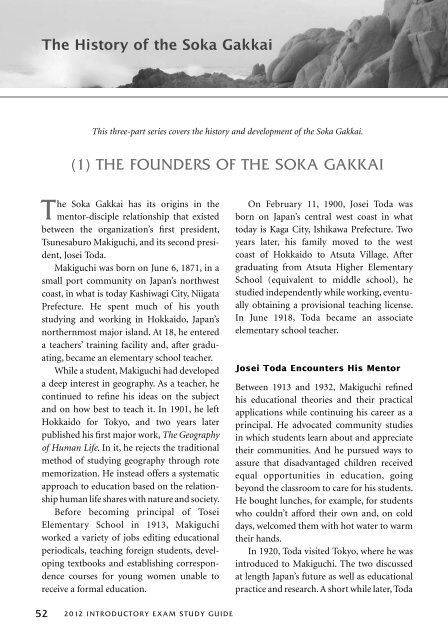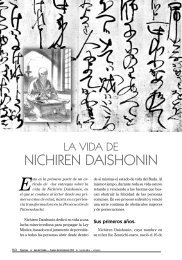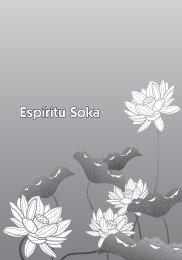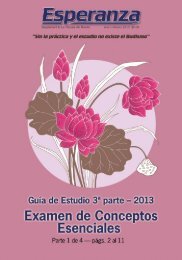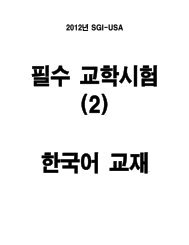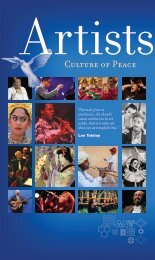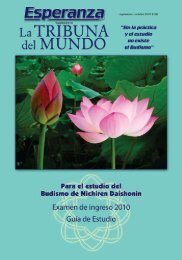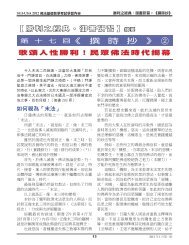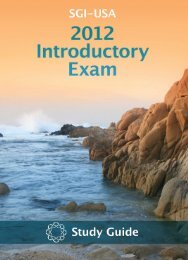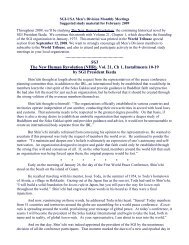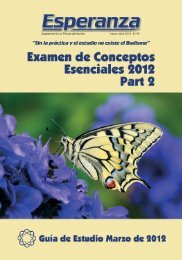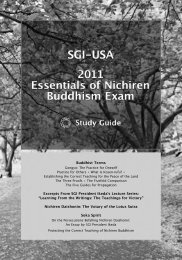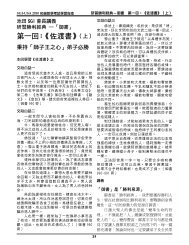(1) THE FOUNDERS OF THE SOKA GAKKAI - SGI-USA
(1) THE FOUNDERS OF THE SOKA GAKKAI - SGI-USA
(1) THE FOUNDERS OF THE SOKA GAKKAI - SGI-USA
Create successful ePaper yourself
Turn your PDF publications into a flip-book with our unique Google optimized e-Paper software.
The History of the Soka Gakkai<br />
This three-part series covers the history and development of the Soka Gakkai.<br />
(1) <strong>THE</strong> <strong>FOUNDERS</strong> <strong>OF</strong> <strong>THE</strong> <strong>SOKA</strong> <strong>GAKKAI</strong><br />
The Soka Gakkai has its origins in the<br />
mentor-disciple relationship that existed<br />
between the organization’s first president,<br />
Tsunesaburo Makiguchi, and its second president,<br />
Josei Toda.<br />
Makiguchi was born on June 6, 1871, in a<br />
small port community on Japan’s northwest<br />
coast, in what is today Kashiwagi City, Niigata<br />
Prefecture. He spent much of his youth<br />
studying and working in Hokkaido, Japan’s<br />
northernmost major island. At 18, he entered<br />
a teachers’ training facility and, after graduating,<br />
became an elementary school teacher.<br />
While a student, Makiguchi had developed<br />
a deep interest in geography. As a teacher, he<br />
continued to refine his ideas on the subject<br />
and on how best to teach it. In 1901, he left<br />
Hokkaido for Tokyo, and two years later<br />
published his first major work, The Geography<br />
of Human Life. In it, he rejects the traditional<br />
method of studying geography through rote<br />
memorization. He instead offers a systematic<br />
approach to education based on the relationship<br />
human life shares with nature and society.<br />
Before becoming principal of Tosei<br />
Elementary School in 1913, Makiguchi<br />
worked a variety of jobs editing educational<br />
periodicals, teaching foreign students, developing<br />
textbooks and establishing correspondence<br />
courses for young women unable to<br />
receive a formal education.<br />
On February 11, 1900, Josei Toda was<br />
born on Japan’s central west coast in what<br />
today is Kaga City, Ishikawa Prefecture. Two<br />
years later, his family moved to the west<br />
coast of Hokkaido to Atsuta Village. After<br />
graduating from Atsuta Higher Elementary<br />
School (equivalent to middle school), he<br />
studied independently while working, eventually<br />
obtaining a provisional teaching license.<br />
In June 1918, Toda became an associate<br />
elementary school teacher.<br />
Josei Toda Encounters His Mentor<br />
Between 1913 and 1932, Makiguchi refined<br />
his educational theories and their practical<br />
applications while continuing his career as a<br />
principal. He advocated community studies<br />
in which students learn about and appreciate<br />
their communities. And he pursued ways to<br />
assure that disadvantaged children received<br />
equal opportunities in education, going<br />
beyond the classroom to care for his students.<br />
He bought lunches, for example, for students<br />
who couldn’t afford their own and, on cold<br />
days, welcomed them with hot water to warm<br />
their hands.<br />
In 1920, Toda visited Tokyo, where he was<br />
introduced to Makiguchi. The two discussed<br />
at length Japan’s future as well as educational<br />
practice and research. A short while later, Toda<br />
52 2012 INTRODUCTORY EXAM STUDY GUIDE
moved to Tokyo and taught at Nishimachi<br />
Elementary, where Makiguchi was principal.<br />
Toda worked with and supported Makiguchi<br />
for the next 23 years.<br />
The Value-Creating Education Society<br />
Toda followed his mentor to Mikasa<br />
Elementary School. Then in 1923, when<br />
Makiguchi was transferred to his next school,<br />
Toda established Jishu Gakkan, a private<br />
preparatory school for students taking the<br />
competitive middle school examinations.<br />
Here, Makiguchi freely pursued his research<br />
and developed his educational theories.<br />
When Makiguchi encountered Nichiren<br />
Buddhism, he saw that the teachings of<br />
Nichiren Daishonin resonated deeply with his<br />
ideals. In 1928, at 57, Makiguchi converted to<br />
Nichiren Buddhism. Toda followed suit.<br />
Fully supporting Makiguchi’s goal of<br />
publishing his educational theory, Toda edited<br />
and organized Makiguchi’s years of notes on<br />
his educational research, practices and experience.<br />
Toda even invested his own funds to<br />
publish Makiguchi’s work.<br />
On November 18, 1930, with Toda’s dedicated<br />
assistance, Makiguchi published the<br />
first of four volumes of Soka kyoikugaku taikei<br />
(The Sytem of Value-Creating Pedagogy).<br />
Tsunesaburo Makiguchi is listed as the author,<br />
Josei Toda, the publisher, and the publishing<br />
entity as “Soka Kyoiku Gakkai” (Value-<br />
Creating Education Society)—the predecessor<br />
of the Soka Gakkai (Value Creation Society).<br />
This publication date is also considered the<br />
day of the Soka Gakkai’s founding.<br />
Makiguchi in this work uses the word soka,<br />
which means value creation—a term derived<br />
from discussions between Toda and Makiguchi.<br />
Soka encompasses Makiguchi’s longdeveloped<br />
theory that the purpose of education<br />
and of life is to create happiness, and in<br />
order to do that one must know how to create<br />
value. He writes: “We begin with the recognition<br />
that humans cannot create matter. We<br />
can, however, create value. Creating value is,<br />
in fact, our very humanity. When we praise<br />
persons for their ‘strength of character,’ we are<br />
really acknowledging their superior ability to<br />
create value.” 1<br />
Practicing Nichiren Buddhism<br />
In 1937, the Soka Kyoiku Gakkai began<br />
meeting regularly as an organization of<br />
educators who supported the theory of Soka<br />
education. But it quickly extended membership<br />
to noneducators and developed into<br />
an organization of people of diverse backgrounds<br />
and occupations. Their common<br />
interest lie in applying the teachings of<br />
Nichiren Buddhism to transforming their<br />
lives and Japanese society.<br />
Eventually, the Soka Kyoiku Gakkai<br />
became a society of lay practitioners of the<br />
Nichiren Shoshu school. However, instead of<br />
depending on priests as other lay Buddhist<br />
organizations did, Makiguchi and Toda were<br />
fully responsible for running all meetings and<br />
giving guidance in faith. The Soka Gakkai<br />
was, from its inception, an organization of<br />
lay believers not restricted by the priesthood’s<br />
formalities.<br />
<strong>THE</strong> HISTORY <strong>OF</strong> <strong>THE</strong> <strong>SOKA</strong> <strong>GAKKAI</strong> 53
Since its establishment, the practice of<br />
Soka Gakkai members has been based on the<br />
original intent of Nichiren Daishonin and<br />
of Buddhism itself: helping people realize<br />
genuine happiness through practice and faith,<br />
and striving for the peace and prosperity<br />
of society. In the 1930s and early 1940s, the<br />
Soka Kyoiku Gakkai grew steadily. Through<br />
propagation efforts, discussion meetings in<br />
members’ homes and occasional larger gatherings,<br />
it reached a membership of about<br />
3,000 households.<br />
A Battle Against Militarism<br />
By the mid-1930s, the Japanese government<br />
had begun placing restrictions on its citizens<br />
as a way to enforce support of its war effort.<br />
It aimed to strengthen public solidarity and<br />
nationalism by requiring citizens to uphold<br />
the state religion, Shinto, and its belief in the<br />
divinity of the Emperor and the nation. Makiguchi<br />
and Toda attracted official scrutiny by<br />
refusing to compromise the humane principles<br />
of Nichiren Buddhism and by pointing<br />
out the erroneous thinking, rooted in Shintoism,<br />
that was leading the country into war.<br />
The repressive Special Higher Police began to<br />
keep Soka Kyoiku Gakkai discussion meetings<br />
under surveillance.<br />
By early 1940, religious organizations faced<br />
increasing pressure to uphold Shinto and<br />
incorporate it into their beliefs. In June 1943,<br />
Nichiren Shoshu priests, fearing government<br />
sanctions, accepted a Shinto talisman and<br />
instructed the Soka Kyoiku Gakkai leaders to<br />
direct its members to do the same.<br />
The priests’ actions directly contradicted<br />
the intent of Nichiren Daishonin and Nikko<br />
Shonin. Instead of courageously protecting<br />
the Buddhist Law, they compromised it in<br />
deference to the Shinto belief system invoked<br />
to promote war. In fact, the priesthood<br />
publicly praised Japan’s declaration of war on<br />
the United States and Great Britain.<br />
In contrast, despite mounting pressures,<br />
Makiguchi and Toda refused to accept the<br />
Shinto talisman and resolutely upheld Nichiren’s<br />
spirit to protect the correct Buddhist<br />
teaching.<br />
On July 6, 1943, Makiguchi was arrested<br />
while attending a discussion meeting in Izu.<br />
On the same day, Toda was arrested in Tokyo,<br />
along with 21 other Soka Kyoiku Gakkai<br />
leaders. They were charged with treason and<br />
violating the Peace Preservation Law, which<br />
targeted dissent against the government.<br />
Among those arrested, only Makiguchi and<br />
Toda refused to compromise their beliefs<br />
throughout the intense interrogations.<br />
President Toda’s Profound<br />
Awakening<br />
In prison, Makiguchi continued to share<br />
Nichiren Buddhism even with his interrogators,<br />
pointing out the error of Japan’s<br />
religious and war policies. Never submitting<br />
to their demands, he upheld his<br />
conviction in Nichiren Buddhism with his<br />
entire being.<br />
Toda’s greatest concern was for his elderly<br />
mentor. He prayed fervently: “I’m still young.<br />
My mentor is seventy-three. Please, if they’ll<br />
54 2012 INTRODUCTORY EXAM STUDY GUIDE
elease him even one day sooner, let me take<br />
the blame for both of us.” 2<br />
From early 1944, Toda earnestly chanted<br />
Nam-myoho-renge-kyo in his jail cell, repeatedly<br />
reading the Lotus Sutra. He pondered<br />
the meaning of a passage that perplexed him<br />
in the Immeasurable Meanings Sutra—the<br />
prologue to the Lotus Sutra—that describes<br />
the essence of the Buddha with 34 negations.<br />
After deep prayer and contemplation,<br />
he came to the realization that the Buddha<br />
is essentially life itself; this life of the Buddha<br />
exists within himself and all people, as well as<br />
in the vast universe.<br />
Then, in November, after chanting more<br />
determinedly than ever, he awakened to the<br />
truth that he himself was among the Bodhisattvas<br />
of the Earth. In the Lotus Sutra,<br />
these are the bodhisattvas entrusted with the<br />
mission to spread the sutra’s teaching in the<br />
Latter Day of the Law, the impure age after<br />
Shakyamuni Buddha’s passing that corresponds<br />
with the present.<br />
On November 18, 1944, Makiguchi died<br />
of malnutrition in the Tokyo Detention<br />
House at age 73. His death coincides with<br />
the anniversary of the Soka Kyoiku Gakkai’s<br />
founding. Undeterred until the end, he lived<br />
in accord with Nichiren’s teachings, dedicated<br />
to restoring the Daishonin’s spirit to<br />
save all people from suffering by spreading<br />
Nam-myoho-renge-kyo.<br />
His disciple, Toda, through the enlightenment<br />
he experienced in prison, awakened to<br />
his mission as a leader of kosen-rufu. This<br />
profound awakening became the starting<br />
point for the Soka Gakkai’s development in<br />
the postwar era.<br />
After the war, at Makiguchi’s memorial<br />
in 1946, Toda expressed his gratitude to his<br />
mentor:<br />
In your vast and boundless compassion,<br />
you let me accompany you even<br />
to prison. As a result, I could read<br />
with my entire being the passage<br />
from the Lotus Sutra “those persons<br />
who had heard the Law / dwelled here<br />
and there in various Buddha lands, /<br />
constantly reborn in company with<br />
their teachers.” 3 The benefit of this<br />
was coming to know the essential<br />
purpose of a Bodhisattva of the Earth,<br />
and to absorb with my very life even<br />
a small degree of the sutra’s meaning.<br />
Could there be any greater happiness<br />
than this 4<br />
The passage “those persons . . . reborn<br />
in company with their teachers” signifies<br />
the deep bond between mentor and disciple<br />
who always strive together for the happiness<br />
of humanity. Josei Toda’s words express his<br />
deep sense of gratitude toward his mentor,<br />
Tsunesaburo Makiguchi.<br />
This is a revision of an article published in the<br />
July–August 2009 Living Buddhism, pp. 42–47.<br />
1. Tsunesaburo Makiguchi, Education for Creative Living, edited<br />
by Dayle M. Bethel and translated by Alfred Birnbaum<br />
(Ames, Iowa: Iowa State University Press, 1994), pp. 5–6.<br />
2. The Human Revolution, p. 90.<br />
3. The Lotus Sutra and Its Opening and Closing Sutras, p. 178.<br />
4. The Human Revolution, p. 1967.<br />
<strong>THE</strong> HISTORY <strong>OF</strong> <strong>THE</strong> <strong>SOKA</strong> <strong>GAKKAI</strong> 55
(2) <strong>THE</strong> DEVELOPMENT <strong>OF</strong> <strong>THE</strong><br />
<strong>SOKA</strong> <strong>GAKKAI</strong> IN POSTWAR JAPAN<br />
Josei Toda was released from prison on July<br />
3, 1945. Though physically frail, he burned<br />
with a fierce resolve to rebuild the Soka<br />
Kyoiku Gakkai, which had virtually dissolved<br />
during World War II.<br />
From early 1946, Toda began lecturing on<br />
the Lotus Sutra and resumed discussion meetings<br />
and propagation efforts. He renamed the<br />
organization the Soka Gakkai (Value Creation<br />
Society), dropping the word kyoiku, meaning<br />
“education” or “pedagogy,” reflecting a broader<br />
commitment to the peace, happiness and<br />
prosperity of society.<br />
Daisaku Ikeda’s Early Years<br />
Daisaku Ikeda was born on January 2, 1928, in<br />
Ota Ward, Tokyo. Beginning in 1937, his four<br />
older brothers were drafted into Japan’s military,<br />
which was waging a war of aggression in<br />
China. He was 13 when the Pacific War broke<br />
out in 1941. Though struggling with tuberculosis,<br />
he supported his family by working at a<br />
munitions factory.<br />
Ikeda was painfully aware of the tragedies<br />
of war. His family lost two homes<br />
in air raids. His eldest brother, Kiichi, on<br />
leave from the warfront, shared accounts of<br />
cruelty perpetrated by Japan’s military that<br />
deeply saddened and angered Ikeda. When<br />
Kiichi died in battle, the pain deepened,<br />
compounded by his parents’ grief.<br />
When the war ended, Ikeda, in his late<br />
teens, sought meaning amid the pain and<br />
chaos of a devastated Japan. The values<br />
esteemed during wartime had proven to be<br />
fraudulent; like many youth his age, he was<br />
tormented by a spiritual void.<br />
Ikeda attended his first Soka Gakkai<br />
discussion meeting on August 14, 1947. When<br />
introduced to Toda, Ikeda posed questions<br />
about life, patriotism, the emperor and the<br />
meaning of Nam-myoho-renge-kyo. Toda’s<br />
answers were to the point, logical and without<br />
pretense, expressing a powerful conviction.<br />
How succinctly he answers! Ikeda thought.<br />
There is no confusion in him. I think I can<br />
believe and follow this man. 1<br />
Ikeda respected the fact that Toda had<br />
been imprisoned for his refusal to compromise<br />
his convictions in the face of pressure<br />
from Japan’s militarist government. As their<br />
dialogue concluded, Ikeda asked if he could<br />
study under Toda. 2<br />
Ten days later, on August 24, he joined<br />
the Soka Gakkai, vowing to regard Toda as<br />
his mentor. In January 1949, two years after<br />
beginning his Buddhist practice, he was hired<br />
at Toda’s publishing company as the editor of<br />
a youth magazine.<br />
Daisaku Ikeda Fully Supports<br />
His Mentor<br />
In July 1949, the Soka Gakkai launched its<br />
Buddhist study magazine, Daibyakurenge.<br />
56 2012 INTRODUCTORY EXAM STUDY GUIDE
Later that year, the postwar economy worsened<br />
and the publishing company foundered.<br />
The youth magazine Ikeda had been editing<br />
was suspended. He quickly switched gears to<br />
devote himself fully to building up Toda’s new<br />
credit association, which soon faced severe<br />
setbacks. He gave everything to support his<br />
mentor in business and in private matters, as<br />
well as in his responsibility to lead the Soka<br />
Gakkai.<br />
In 1950, economic disorder intensified,<br />
seriously impairing Toda’s entrepreneurial<br />
efforts. Though Toda’s businesses had financed<br />
the initial growth of the Soka Gakkai, as his<br />
enterprises faltered and his debt grew, some<br />
members—especially those connected to his<br />
unsuccessful credit association—lost confidence<br />
in him and the Soka Gakkai. On August<br />
23, the credit association was suspended. To<br />
avoid burdening the organization with his<br />
financial struggles, Toda resigned as general<br />
director of the Soka Gakkai on August 24.<br />
One by one, Toda’s employees left, but he<br />
remained steadfast, devoting his entire being<br />
to repaying the company’s massive debt. Ikeda<br />
fervently supported him, determined to help<br />
Toda become financially solvent and to see<br />
him become president of the Soka Gakkai.<br />
Toda began privately tutoring his young<br />
disciple, who a year earlier had quit night<br />
school to fully support his mentor, in a variety<br />
of academic subjects and in Buddhism, as well.<br />
Toda shared his vision for the future<br />
with Ikeda. His goals ranged from starting a<br />
newspaper for the Soka Gakkai to founding a<br />
university. In time, both the newspaper Seikyo<br />
Shimbun (1951) and Soka University (1971)<br />
emerged as the fruit of their joint efforts.<br />
Josei Toda Becomes Second<br />
President of the Soka Gakkai<br />
Josei Toda and Daisaku Ikeda struggled<br />
intensely between 1950 and 1951 to turn<br />
Toda’s financial situation around. Toda<br />
resolved: “Whatever hardship may befall me,<br />
I must put it aside. This I will not do for my<br />
own sake but for the cause of fulfilling my<br />
mission. I must not by any means leave even<br />
a single teaching of Nichiren Daishonin’s<br />
unfulfilled.” 3<br />
During this tumultuous time, Ikeda strove<br />
to fulfill his deepest wish—that his mentor be<br />
freed from his constricting financial situation<br />
and become president of the Soka Gakkai.<br />
Within a year, Toda’s financial difficulties<br />
were behind him, though he and Ikeda<br />
suffered from ongoing health troubles. Ikeda<br />
describes the struggles of that period as “the<br />
deciding factors of the Soka Gakkai’s development<br />
and existence today.” 4<br />
On May 3, 1951, Josei Toda became the<br />
second Soka Gakkai president. In his inaugural<br />
address, he vowed to accomplish a<br />
membership of 750,000 households. At the<br />
time, active Soka Gakkai families numbered<br />
approximately 3,000. Many in attendance<br />
could not comprehend how his goal would<br />
be achieved. Toda, however, had already<br />
begun preparations for a widespread propagation<br />
movement and was so confident that<br />
he told the members, “If my goal should not<br />
be attained by the end of my life, you need<br />
not hold a funeral for me, but just throw my<br />
remains into the sea off Shinagawa, all right” 5<br />
Just prior to becoming president, on<br />
April 20, Toda launched the Soka Gakkai’s<br />
<strong>THE</strong> HISTORY <strong>OF</strong> <strong>THE</strong> <strong>SOKA</strong> <strong>GAKKAI</strong> 57
newspaper, Seikyo Shimbun. He formed the<br />
women’s division on June 10, the young men’s<br />
division on July 11 and the young women’s<br />
division on July 19.<br />
In January 1952, Toda assigned Ikeda<br />
responsibility for the organization’s Kamata<br />
Chapter. Ikeda devoted himself to meeting<br />
personally with and encouraging many<br />
members, and the following month, the<br />
chapter’s membership increased by an<br />
unprecedented 201 households.<br />
Toda firmly believed that diligent and<br />
correct study of Nichiren’s writings was<br />
indispensable for the progress of kosen-rufu.<br />
He commissioned former high priest and<br />
Nichiren Buddhist scholar Nichiko Hori to<br />
help compile all of Nichiren’s existing writings.<br />
Gosho zenshu (The Collected Writings of<br />
Pablo Barilari<br />
Nichiren Daishonin) was published in April<br />
1952, marking the 700th anniversary of the<br />
establishment of Nichiren’s teachings. This<br />
made it possible for Soka Gakkai members<br />
to make the writings and teachings of Nichiren<br />
Daishonin a solid foundation for their<br />
Buddhist practice. In September, the Japanese<br />
government formally recognized the Soka<br />
Gakkai as a religious organization.<br />
Ikeda, in the meantime, took on various<br />
organizational responsibilities. In January<br />
1953, he became leader of the young men’s<br />
division First Corps, and in April, he was<br />
appointed acting Bunkyo Chapter leader. The<br />
following March, he became the Soka Gakkai<br />
youth division leader.<br />
Struggles With Authority<br />
Nichiren Daishonin’s determination to establish<br />
“the correct teaching for the peace of<br />
the land” defined his lifelong battle for the<br />
happiness of all people and realizing peace<br />
in society. Based on that same spirit, and to<br />
confront corruption in politics that caused<br />
people suffering and had led to religious<br />
repression, the Soka Gakkai for the first time<br />
endorsed candidates for the national parliament<br />
in April 1955.<br />
Daisaku Ikeda led propagation efforts in<br />
the Kansai region, which resulted in Osaka<br />
Chapter growing by an unprecedented 11,111<br />
member-households in the single month of<br />
May 1956. In July, Ikeda was put in charge of<br />
the Soka Gakkai election effort in Osaka.<br />
Three candidates sponsored by the organization<br />
in Osaka won seats in the national<br />
58 2012 INTRODUCTORY EXAM STUDY GUIDE
elections. With this victory, the Soka Gakkai<br />
came to be regarded as an influential popular<br />
movement. At the same time, it faced heightened<br />
opposition from various groups that<br />
felt threatened by its success. For example,<br />
in June 1957, Ikeda went to Hokkaido, where<br />
the Yubari branch of the Japan Coal Miners<br />
Union, which had strong links to the country’s<br />
Communist Party, had attempted to<br />
oppress and intimidate local coal miners who<br />
belonged to the Soka Gakkai. He protested<br />
such treatment, taking action through debate<br />
and dialogue to resolve the problem.<br />
Immediately after this, on July 3, 1957,<br />
the Osaka police arrested and detained Ikeda,<br />
falsely charging him with election fraud,<br />
though other Soka Gakkai members had<br />
naively committed the infractions.<br />
Ikeda was interrogated for 15 days. Prosecutors<br />
threatened to arrest Toda if Ikeda did<br />
not confess to the charges. Toda’s health was<br />
failing, and Ikeda could not bear the thought<br />
of his mentor returning to jail. To protect<br />
his mentor, Ikeda conceded. On July 17, he<br />
was indicted and released from the Osaka<br />
Detention Center. After a trial that continued<br />
for four years, he was found innocent of all<br />
charges on January 15, 1962.<br />
Toda denounced those who would use them<br />
as “devils” and “evil incarnate.” He vowed to<br />
defeat the dark tendency in human life that<br />
would justify their use. This declaration set<br />
the tone for the Soka Gakkai’s future peace<br />
movement. 6<br />
In December, the organization’s membership<br />
reached 750,000 households—Toda’s<br />
ultimate goal. In March 1958, the Grand<br />
Lecture Hall, donated by the Soka Gakkai, was<br />
completed at the head temple, Taiseki-ji, near<br />
Mount Fuji.<br />
On March 16, 6,000 youth assembled<br />
from throughout Japan at Taiseki-ji. At this<br />
gathering, though weakened by illness, Toda<br />
boldly passed the responsibility for accomplishing<br />
kosen-rufu to the youth, declaring,<br />
“The Soka Gakkai is the king of the religious<br />
world.” 7 March 16 is celebrated today as<br />
Kosen-rufu Day.<br />
On April 2, Toda died at age 58. Having<br />
drawn upon his enlightenment in prison as<br />
a source of strength, he had succeeded in<br />
rebuilding the Soka Gakkai and creating a solid<br />
foundation for kosen-rufu. His legacy includes<br />
the numerous successors he raised, among<br />
them the future third president of the Soka<br />
Gakkai, his closest disciple, Daisaku Ikeda.<br />
Entrusting the Future of Kosen-rufu<br />
to the Youth<br />
On September 8, 1957, Josei Toda passionately<br />
and publicly condemned all use of nuclear<br />
weapons, calling for their immediate abolition.<br />
Because of the mass death and devastation<br />
brought about by nuclear weapons,<br />
This is a revision of an article published in the<br />
September–October 2009 Living Buddhism, pp. 42– 49.<br />
1. See The Human Revolution, p. 232.<br />
2. See Ibid., 224–32.<br />
3. Ibid., 529.<br />
4. See Ibid., 539–40.<br />
5. Ibid., 563.<br />
6. See Ibid., 485–87.<br />
7. Ibid., 1895.<br />
<strong>THE</strong> HISTORY <strong>OF</strong> <strong>THE</strong> <strong>SOKA</strong> <strong>GAKKAI</strong> 59
(3) ESTABLISHING A WORLDWIDE<br />
NETWORK <strong>OF</strong> BUDDHIST HUMANISM<br />
On May 3, 1960, Daisaku Ikeda was<br />
inaugurated third president of the Soka<br />
Gakkai. He declared, “Though I am young,<br />
from this day I will take leadership as a representative<br />
of President Toda’s disciples and<br />
advance with you another step toward the<br />
substantive realization of kosen-rufu.” 1<br />
Determined to fulfill second Soka Gakkai<br />
president Josei Toda’s wish to spread Nichiren<br />
Buddhism worldwide, on October 2,<br />
1960, five months after becoming president,<br />
he visited nine cities in North and South<br />
America. In each country he visited, President<br />
Ikeda encouraged the Soka Gakkai members<br />
living there, most of whom were Japanese<br />
immigrants.<br />
In New York, President Ikeda and his party<br />
visited the United Nations headquarters.<br />
There, he contemplated the role and potential<br />
of that international body in creating peace<br />
in the world. He has continued since then to<br />
support the United Nations and offer, through<br />
proposals and dialogues, a vision of the vital<br />
role that body can play as an agent representing<br />
the will of ordinary people around<br />
the world for peace and working toward that<br />
common aim. In 1983, President Ikeda wrote<br />
his first peace proposal to the United Nations,<br />
offering a perspective and detailed suggestions<br />
on issues such as nuclear abolition, the<br />
environment and strengthening the United<br />
Nations. He has submitted a peace proposal<br />
each year since.<br />
In January 1961, his travels included<br />
a visit to India. During the trip, and particularly<br />
at Bodh Gaya—the place where Shakyamuni<br />
attained enlightenment—he pondered<br />
creating an institution dedicated to researching<br />
Asian philosophy and culture as a means to<br />
promote dialogue and peace. The following<br />
year, he established the Institute of Oriental<br />
Philosophy.<br />
In 1963, he founded the Min-On Concert<br />
Association, dedicated to fostering peace<br />
through cultural and artistic exchange. He<br />
writes: “Cultured people value peace and lead<br />
others to a world of beauty, hope and bright<br />
tomorrows. Tyrannical authority, on the other<br />
hand, only leads people to darkness—the<br />
opposite of art.<br />
“For that reason, nurturing and spreading<br />
an appreciation for art and culture are crucial<br />
in creating peace.” 2<br />
President Ikeda traveled extensively<br />
throughout Japan to encourage Soka Gakkai<br />
members. He focused on raising the next<br />
generation of leaders, conducting lectures on<br />
Nichiren Daishonin’s teachings for student<br />
division representatives. In June 1964, he<br />
created the high school division and in 1965,<br />
the junior high school and elementary school<br />
divisions.<br />
In 1965, he began writing his serialized<br />
novel The Human Revolution, which details<br />
President Toda’s struggle to reconstruct the<br />
Soka Gakkai after being released from prison<br />
60 2012 INTRODUCTORY EXAM STUDY GUIDE
at the end of World War II. This and its<br />
ongoing sequel, The New Human Revolution,<br />
chronicle the history of the Soka Gakkai spanning<br />
80 years.<br />
Forging Peace Through Dialogue<br />
To create pathways to peace, President Ikeda<br />
often exchanges views with cultural, political,<br />
educational and artistic leaders from around<br />
the world—an estimated 1,600 such encounters<br />
thus far. President Ikeda’s best known<br />
dialogue, with eminent British historian<br />
Arnold J. Toynbee, took place over two-anda-half<br />
years in the early 1970s. Their discussion<br />
opened many doors for him to meet and<br />
exchange views with notable thinkers over<br />
the ensuing years, including former Soviet<br />
president Mikhail Gorbachev, Nobel Peace<br />
laureates Linus Pauling and Betty Williams,<br />
futurist Hazel Henderson and many others.<br />
In 1974, when he visited China, President<br />
Ikeda saw people living in fear of Soviet<br />
attack. He soon after visited the Soviet Union<br />
to confirm with its leaders that it would not<br />
attack China. He returned to China to convey<br />
this assurance. In one year, President Ikeda<br />
engaged in intensive dialogues with political<br />
figures of these two countries to nurture<br />
bonds of trust and plant seeds of peace.<br />
Leon Strijak of Moscow University interpreted<br />
for President Ikeda’s 1974 meeting<br />
with Soviet Premier Aleksey Kosygin. He<br />
recalls: “The subject matter of the Ikeda-<br />
Kosygin meeting was quite different from that<br />
normally discussed by Japanese delegations<br />
visiting Moscow. They spoke about war and<br />
peace, about war and its victims and how to<br />
prevent war.” 3<br />
The following January, he flew to the<br />
United States, where he spoke with leaders<br />
who could move the world toward peace.<br />
That same month, he traveled to Guam, and<br />
there participated in events culminating in<br />
the founding of the Soka Gakkai International<br />
on January 26. He writes: “The <strong>SGI</strong><br />
was established in the midst of my efforts to<br />
bring the United States, China and the Soviet<br />
Union closer together through dialogue in<br />
a world shrouded by the dark clouds of the<br />
Cold War.<br />
“History teaches us the bitter lesson that<br />
coercive balances of power and attempts to<br />
resolve conflicts through military force only<br />
create greater division. Choosing dialogue<br />
is the key to building peace and achieving a<br />
victory of our inner humanity.<br />
“Since the founding of the <strong>SGI</strong>, this truth<br />
has continued to ring out vibrantly across the<br />
globe as the cry of world citizens.” 4<br />
Former chair of the China-Japan Friendship<br />
Association, Sun Pinghua, said of President<br />
Ikeda’s diplomatic efforts: “The ‘golden<br />
bridge [of trust]’ erected by President Ikeda<br />
has a peculiar construction. The more people<br />
cross it, the more solid it becomes.” 5<br />
Separation From Nichiren Shoshu<br />
The Soka Gakkai, from its inception in 1930,<br />
was the Nichiren Shoshu priesthood’s primary<br />
benefactor. The Soka Gakkai’s growth after<br />
World War II transformed Nichiren Shoshu<br />
from a poverty-stricken and obscure Buddhist<br />
<strong>THE</strong> HISTORY <strong>OF</strong> <strong>THE</strong> <strong>SOKA</strong> <strong>GAKKAI</strong> 61
school into one of the largest religious bodies<br />
in Japan.<br />
As Soka Gakkai membership grew during<br />
the 1970s, President Ikeda began to point<br />
out in speeches and lectures that, from the<br />
perspective of Nichiren Daishonin’s writings,<br />
lay believers should in no way be considered<br />
inferior to priests. Increasing reports of<br />
priests acting in an authoritarian, condescending<br />
and even abusive manner toward<br />
the laity prompted his actions. Lay members<br />
complained of mounting pressure to offer<br />
large financial donations to the priests while,<br />
at the same time, being treated disrespectfully.<br />
President Ikeda tried to engage the priests in<br />
dialogue about these concerns.<br />
Many priests felt threatened by his public<br />
assertions and his considerable influence.<br />
A lawyer for the Soka Gakkai attempted to<br />
undermine President Ikeda by exploiting<br />
these fears, feeding the priests false reports<br />
about the Soka Gakkai’s supposed ill intentions.<br />
Tensions grew in a climate of accusation<br />
and counteraccusation.<br />
In an essay about that intense period,<br />
President Ikeda writes: “I agonized over the<br />
situation. I knew I had to prevent further<br />
suffering from being inflicted on our members<br />
and to protect them from the persecution of<br />
the priests. Mr. Toda had said that the Soka<br />
Gakkai was more precious to him than his own<br />
life. The Gakkai is an organization that follows<br />
the Buddha’s intent and decree to the letter; it<br />
is dedicated to the happiness of the people, the<br />
propagation of Buddhism and world peace.<br />
“My resolve to take all the blame upon<br />
myself and to resign the presidency gradually<br />
grew firm within me.” 6<br />
President Ikeda stepped down as president<br />
on April 24, 1979. The priesthood set harsh<br />
restrictions, forbidding him from addressing<br />
Soka Gakkai members at the organization’s<br />
gatherings and from contributing articles to<br />
the organ publications.<br />
Despite these restrictions, he found ways to<br />
encourage members. He penned short poems<br />
and calligraphy for individuals. He traveled<br />
throughout the country, visiting members in<br />
their homes. And he took what had seemed a<br />
debilitating setback as an opportunity to fulfill<br />
an even grander vision—to fortify the <strong>SGI</strong><br />
and its mission to establish a solid network for<br />
building peace throughout the world.<br />
The conflict between the Soka Gakkai and<br />
the priesthood eventually seemed to be settled<br />
for a time, and President Ikeda, as honorary<br />
president of the Soka Gakkai and <strong>SGI</strong> President,<br />
again fulfilled a more public role as a<br />
Buddhist leader. In the ensuing years, however,<br />
Nikken, the 67th high priest, conspired to<br />
disband the Soka Gakkai or bring it under<br />
direct control of the priesthood.<br />
After making public a list of groundless<br />
complaints against the lay organization as<br />
a pretext, the priesthood refused repeated<br />
requests from the Soka Gakkai for dialogue.<br />
Unable to win Soka Gakkai members to its<br />
side as Nikken had planned, the priesthood<br />
excommunicated the entire organization in<br />
November 1991.<br />
Nikken had hoped that excommunication<br />
would cause large numbers of members to<br />
abandon the <strong>SGI</strong> and follow the priesthood,<br />
but only a very small percentage did so. The<br />
vast majority remained with the <strong>SGI</strong>, viewing<br />
the excommunication as liberation from<br />
62 2012 INTRODUCTORY EXAM STUDY GUIDE
an archaic and oppressive institution. The<br />
<strong>SGI</strong> now had the freedom to pursue a more<br />
modern and humanistic approach to applying<br />
Nichiren Buddhism to the conditions of<br />
global society and creating bonds of trust and<br />
friendship throughout the world.<br />
Building an Everlasting Foundation<br />
for Peace<br />
Daisaku Ikeda, now 84, has continued to<br />
pursue dialogue with philosophers, scientists<br />
and world leaders, as well as submitting<br />
annual peace proposals to the United Nations.<br />
Numerous institutions, governments and<br />
organizations have acknowledged him as a<br />
genuine builder of peace.<br />
He continuously encourages members to<br />
develop and strengthen themselves through<br />
Buddhist practice so that they may establish<br />
happiness and peace in their lives and their<br />
communities. And he continues writing daily<br />
installments of The New Human Revolution,<br />
as well as messages, essays and ongoing study<br />
series such as “Learning From the Writings<br />
of Nichiren Daishonin: The Teachings for<br />
Victory.” He constantly encourages youth<br />
around the world to share the same sense of<br />
responsibility he has, to build an everlasting<br />
foundation for world peace grounded in the<br />
most humane Buddhist principles.<br />
For more than six decades, President Ikeda<br />
has kept the vision of his mentor, Josei Toda,<br />
close to his heart. He says: “Mr. Toda was<br />
focused on the world. He was thinking about<br />
humanity as a whole. He once said earnestly:<br />
‘Nichiren Buddhism is like the light of the<br />
sun. By embracing faith in the Mystic Law,<br />
countless Soka Gakkai members have risen<br />
up from the depths of despair and vibrantly<br />
revitalized their lives.’ The Mystic Law makes<br />
it possible for humankind to transform its<br />
karma. It is here that we find the mission of<br />
the Soka Gakkai, an organization dedicated to<br />
building peace.” 7<br />
1. The Human Revolution, p. 1971.<br />
2. Discussions on Youth, second edition, p. 169.<br />
3. Keiko Kimura, Daisaku President Ikeda Up Close documentary<br />
(Owners Promotion, Inc.: Tokyo, 2001).<br />
4. January 1, 2009, World Tribune, p. 4<br />
5. Sun, Pinghua, “Meiyo kaicho, chunichi yuko kyokai no<br />
Sonheika kaicho to kandan” (President Ikeda’s Dialogue<br />
With Sun Pinghua, Chair of the China-Japan Friendship<br />
Association), July 20, 1990, Seikyo Shimbun, p. 1.<br />
6. May 14, 1999, World Tribune, p. 7.<br />
7. March 20, 2009, World Tribune, p. 4.<br />
<strong>THE</strong> HISTORY <strong>OF</strong> <strong>THE</strong> <strong>SOKA</strong> <strong>GAKKAI</strong> 63


